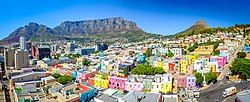Bo-Kaap
| Bo-Kaap | ||
|---|---|---|
|
|
||
| Coordinates | 33 ° 55 ′ S , 18 ° 25 ′ E | |
| Basic data | ||
| Country | South Africa | |
| Western cape | ||
| metropolis | City of Cape Town Metropolitan Municipality | |
| ISO 3166-2 | ZA toilet | |
| height | 84 m | |
| Residents | 6000 (2010) | |
| founding | 18th century | |
|
View of Bo-Kaap and Table Mountain
|
||
Bo-Kaap ( Afrikaans ; German for example: "Above the Cape"), also Malay Quarter ("Malaienviertel") or Slamsebuurt ("Islamviertel"), was called Schotschekloof until 2017 and is a district of Cape Town in the South African province of Western Cape . It originated as a settlement of Cape Malays , who still make up the majority of the population today.
geography
The district is located between the city center and the slope of Signal Hill in the west of Cape Town center, about one kilometer from Cape Town Train Station. To the north is the De Waterkant district.
For historical reasons, Bo-Kaap is about one square kilometer in size; over 6000 people live there. Over 90 percent of them are Muslims, 90 percent of whom are Shāfiʿites . There are a total of ten mosques in the Bo-Kaap. The district is characterized by narrow, steep streets and facades painted in different bright colors. The architectural style is a synthesis of Cape Dutch and Edwardian architecture .
The district was officially run as Sub Place Schotschekloof until mid-2017 and is located between Signal Hill and Buitengracht Street, the M62 Motorway . In 2011 it had 3,203 residents. Today the name is officially Bo-Kaap.
history
Bo-Kaap was settled by Cape Malays in the 18th century after they were released from slavery . The oldest preserved house in its original state is today's Bo-Kaap Museum from the 1760s. From here Tuan Guru gave important impulses to the Islamization of the slaves and the released black population. As a result, several mosques were built, in 1794 the Auwal Mosque in Dorp Street - the first mosque in South Africa - from 1811 the Palm Tree Mosque in Long Street , which historically belongs to Bo-Kaap, and in 1844 the Nural Islam Mosque. In the 1820s, according to research by Muslim clergy of the Bo-Kaap, written documents were first written in Afrikaans ; they were written in Arabic script . In 1886, by order of the authorities, the Muslim burial site Tana Baru Cemetery , established in 1805, was to be closed; the - ultimately unsuccessful - resistance of thousands of residents is considered the most important action of the Cape Malay against the authorities.
After the end of apartheid and the repeal of the Group Areas Act , many houses were repaired. However, with the arrival of wealthy residents and the termination of existing leases, extensive gentrification began. In 2016, plans for a 17-story high-rise with luxury apartments became known.
Economy and Transport

Bo-Kaap is a tourist attraction with its brightly colored houses, mosques, Bo-Kaap Museum and cobblestone streets . The M62 road runs through Bo-Kaap.
literature
- Robyn Wilkinson, Astrid Kragolsen-Kille: Bo-Kaap: inside Cape Town's Malay Quarter. Struik, Cape Town 2006, ISBN 978-1770072817 , excerpts from books.google.de .
Web links
- Tourist website (English)
Individual evidence
- ↑ a b Description at kapstadt.de , accessed on May 17, 2015
- ↑ a b Description at bokaap.co.za (English), accessed on May 17, 2015
- ↑ a b Bo-Kaap at kapstadt-enthaben.de , accessed on May 17, 2015
- ↑ Description at bokaap.co.za (English), accessed on May 17, 2015
- ↑ 2011 census , accessed May 17, 2015
- ↑ Auwal Mosque, website (English), taken on July 14, 2016
- ^ Alan Mountain: To Unsung Heritage: Perspectives on Slavery . New Africa Books, 2004, ISBN 9780864866226 , p. 94 (accessed July 14, 2016).
- ↑ Yazeed Kamaldien: Arabic roots of Afrikaans laid bare in new book. iol.co.za on December 28, 2018, accessed on September 13, 2019
- ^ Tana Baru Cemetery uprising at sahistory.org.za , accessed on May 17, 2015
- ↑ Ronnie Donaldson, Nico Kotze, Gustav Visser, JinHee Park, Nermine Wally, Janaina Zen, Olola Vieyra: An Uneasy Match: Neoliberalism, Gentrification and Heritage Conservation in Bo-Kaap, Cape Town, South Africa. In: Urban Forum. Vol. 24/2, June 2013, pp. 173-188 (abstract) , accessed on May 17, 2015
- Jump up ↑ Cape Town - The Curse of the Colorful Houses. sueddeutsche.de from September 20, 2016, accessed on March 21, 2017


